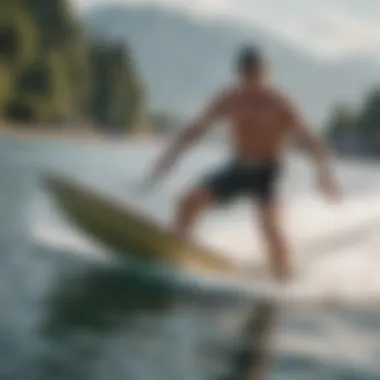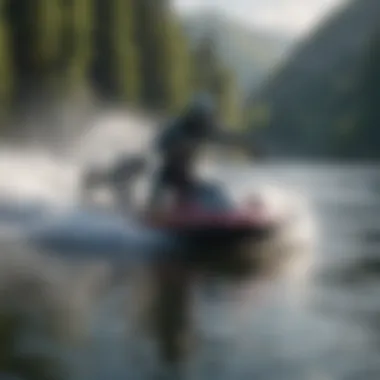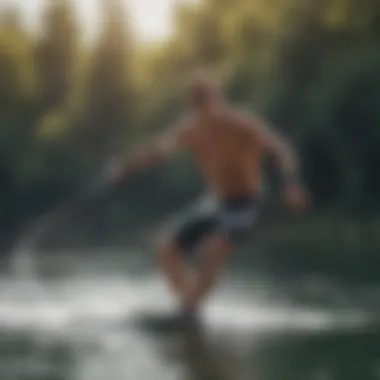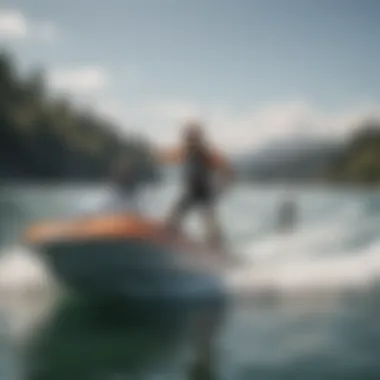The Art and Science of Waterskiing: A Comprehensive Guide


Intro
Waterskiing embodies both grace and an adrenaline rush, captivating those who pursue it. Esteemed as a sport and social activity, it draws participants into dynamic settings, from serene lakes to vibrant coastlines. Though the physical and technical demands are observable, the essence of waterskiing transcends mere recreation.
Understanding the foundational tools and gear is paramount. Equipment lays the groundwork for achievements in the sport. Consequently, knowledge regarding developments and advancements in the equipment world can drastically improve the experience and effectiveness on the water.
Delving into techniques reveals an intricate layer of waterskiing. The pursuit of mastery requires acute skill acquisition and physical training. It stands crucial to explore correct posture, line tension, and turns, thereby promoting smooth navigation on water.
Moreover, safety is non-negotiable. Recognizing inherent risks aids athletes in developing frameworks that reduce accidents. Knowing safety protocols can announce the difference between exhilarating fun and an unfortunate experience.
Lastly, the community extends a welcoming hand. Bonding through competitions and shared adventures fosters a unique culture that supports an extreme sports lifestyle. Everyone—from novices to pros—can unite through the shared passion for waterskiing.
With this overview, we lay the groundwork for a comprehensive investigation that illuminates each vital aspect that contributes to waterskiing's unique allure.
Equipment and Gear
To successfully navigate the waterskiing landscape, understanding the crucial equipment is essential.
Overview of Essential Gear
Key gear includes skis, bindings, ropes, and personal flotation devices. Let’s break it down:
- Skis: Vary in shape and size, impacting performance. Choose from wide skis for stability or more narrow models for advanced tricks.
- Bindings: Important for getting the right connection between the skier and the ski.
- Ropes: Typically constructed from high-tenacity polyethylene or nylon, they provide responsive feedback to the skier.
- Personal Flotation Devices (PFDs): a must-have safety item, helping keep skiers buoyant in water.
Detailed Descriptions of Top Brands
Several brands distinguish themselves in this niche sports arena. Well-known companies include HO Sports, Aerial Wakeboarding, and Connelly Skis. These brands provide top-quality equipment catering to various skill levels. The intricate designs from HO Sports boast innovation, while Connelly focuses on adaptability and durability for different water conditions.
Tips on Maintenance and Upgrades
Maintenance ensures equipment longevity. Regular checks after each use ensure the components are intact. For example, ropes fray over time and may need replacement. Upgrading equipment capable of matching skills can enhance performance. Keeping an eye on spacious boot fitting can also allow proper positioning and safety.
“Investing in the right gear changes the experience profoundly. Quality equips exhilarating journey and manages risks efficiently.”
Next, we will analyze the techniques and training protocols.
Techniques and Training
Training forms the bedrock of mastering skills. Fetching essential techniques shapes successful skiers.
Breakdown of Skills and Techniques
Fluidity in performance pivots on key positions and maneuvers in waterskiing, including:
- Gaining balance on the skis
- Navigating turns smoothly
- Jump techniques, dealing with ramp height Implementing equal weight distribution also plays a critical role. Frequently stressing above relationship with rope speed fortifies skills.
Training Exercises and Routines
To improve strength, agility, and endurance, try specific training routines, such as:
- Dry land drills for balance: Practicing posture, holding a towel for connection simulation.
- Custom strength workouts focusing on core and legs prepares overall support during skiing sessions.
- Regular cardiovascular activities enhance stamina allowing better performance.
Insight from Professional Athletes
Lessons from experienced competitors equip aspiring waterskiers with techniques honed over years. Engaging in consistent practice becomes essential.
Safety and Risk Management
As watersports plunge into thrill, dedication to safety must reside as priority.
Importance of Safety Protocols
Waiting around may avert dangers by simply wearing ropes to measure connected distances. This minimizes slips on water's surface and secures better control.
Common Risks and Potential Hazards
With waterskiing condensing velocity and speed, key risks include:
- Collisions with obstacles: ensure vision clarity
- Tethering to boats appropriately reduces risks
Strategies for Risk Mitigation
Skilled routines substantiate preparation. Testing the environment also proves crucial, ensuring athletes can retake proper routes from potential collisions. Strengthen communication and emphasize drivers’ verbal recognition with passengers throughout.
Events and Competitions


Competing ignites the spirit amidst an evolving range of enriching events to cheer.
The Extreme Sports Community
Numerous competitions occur globally, fostering athletes' engagement. Notably, tournaments like USA Water Ski National Championships draw wide participation, backstage boasting high-profile individuals like Ryan Dodd setting benchmarks in performance.
Communication from Competitors
Designing profiles spotlighting individual skills highlight lessons behind performances. Professional identities create connection screenshots for new contributors and gatherings.
Lifestyle and Community
Waterskiing transcends training; it integrates into holistic lifestyles.
Features on Lifestyle Aspects
Active information stems from connection elements, showcasing adoption practices. Engaging in physical activity increases strong communal bonds while growing mental decisiveness from friendships come from comparable endeavors.
Tips for Balance
Juggling time for waterskiing alongside life responsibilities can arrive challenging.
- Delegating days allows incorporation of alternate workouts into mental health actions for balance
- Joining local clubs connects enthusiasts boosting complementary skills through practice at shared times.
","v":1
Preface to Waterskiing
Waterskiing combines sport and leisure. it requires a balance of courage and skill. For many, the idea of gliding over water at speed is thrilling. However, this sport is not merely for entertainment; it provides numerous benefits including physical fitness, stress relief, and a sense of community.
Several considerations make waterskiing an important topic of discussion. First, it attracts thrill-seekers looking for adventure. Learning the essentials can improve skills and enhance safety. Proper techniques ensure the experience is enjoyable and minimizes risk.
Definition and Overview
Waterskiing involves being towed behind a boat while standing on a pair of skis. The individual holds onto a tow rope attached to the boat. As the boat accelerates, the skier must maintain balance and control. This unique challenge appeals to a wide range of people, from beginners to experienced athletes.
The sport gained prominence in the mid-20th century. Political events and cultural shifts impacted its growth. Today, waterskiing remains a popular watersport enjoyed around the globe.
To fully appreciate waterskiing, understanding its fundamentals is crucial. The coordination of movements requires practice. Competitors demonstrate remarkable skill in various techniques, enhancing the spectacle.
The Evolution of the Sport
Waterskiing's roots can be traced to passion for water and innovation. It began in the 1920s when recreational boaters sought new ways of enjoying water bodies. Early skiers used wooden skis crafted from logs.
By the 1960s, enthusiasm for the sport surged. Organised competitions emerged, leading to developments in equipment and training. Companies like MasterCraft and Nautique started creating specialized boats to complement the sport.
As years passed, technology affected the equipment significantly. Advanced materials lead to versatile skiwynfindings. Structures like wakeboards also developed, contributing to the variation within the sport. The introduction of safety gear improved participant protection, reducing injuries and making waterskiing even more accessible and attractive for a broader audience.
Improvements have shaped how it’s enjoyed today. Modern enthusiasts appreciate an array of styles. Leuten find connections between technical skill and shared community experiences. The sport combines art and science, providing excitement, challenge, and a rich social network.
Historical Context
Understanding the historical context of waterskiing provides crucial insights into its growth and evolution. Waterskiing began as a novel pastime and has transformed into a highly competitive sport. This background allows enthusiasts and competitors alike to appreciate not just the techniques involved but the cultural sentiments that devices this sporting marvel.
Origins of Waterskiing
The origins of waterskiing can be traced back to the early 1920s. George G. Grant piloted the first known successful attempt at this water-based activity in Lake City, Minnesota. His innovative experimentation involved using wooden planks tied to his feet while being pulled by a motorboat. This became the foundation that many enthusiasts, and eventually competitive athletes, would build upon.
The concept gained traction in the ensuing years. Rick Brown and his friends played a vital role in popularizing waterskiing on a broader scale through various tricks and techniques that expanded the sport’s appeal. By the mid-20th century, waterskiing was no longer a niche hobby but rather a respected activity within sporting circles. Global interest grew, leading to participation from people from diverse backgrounds.
Significant persons in those earlier days shaped the sport’s trajectory. Competitions emerged and are aligned closely with the foundation stone laid in Minnesota. The roots are embedded not only in technical skills but also in the community and culture that embraced this vibrant means of enjoying water environments.
Milestones in Waterskiing Development
To fully appreciate waterskiing today, one must consider its transformative milestones throughout the decades. Key developments followed George G. Grant's initial experiments, catapulting the sport further into the public eye.
- 1939: The introduction of the first dedicated waterskiing competitions spurred continent-wide interest. Organizations formed rapidly to contribute to regulation and structure in competitive formats.
- 1950s: Waterskiing leadership established world championships, signifying international competition. As athletes pushed the limits, new styles and techniques developed, diversifying the sport.
- 1970s-1980s: Technological advancements led to improved ski designs, allowing for enhanced performance capabilities. Also, ski equipment began emphasizing safety, encouraging growing participation rates.
With each milestone, the waterskiing landscape witnessed a significant shift. Today, it encapsulates a blend of art and science through its refined methodologies, innovations, and community-focused initiatives alongside formal training programs. This rich heritage continues to shape not only participants and competitors but also influential organizations globally.
“Historical context informs current practices, providing both perspective and direction for future growth.”
Essential Equipment
The foundation of waterskiing lies largely in the equipment employed. Choosing the right tools can significantly affect performance, safety, and overall enjoyment of the sport. Each piece of gear has distinct features that cater to different skill levels and preferences, making it essential to carefully consider each element.
Choosing the Right Skis


In waterskiing, skis can vastly influence your skiing experience. Sur learner should opt for skis that match their skill level. Beginners typically benefit from wider skis as they provide better stability, reducing the likelihood of falls. As skill improves, skiers can transition to narrower skis for more agility and a sharper turn radius.
Several materials used in ski construction affect performance as well. Fiberglass skis tend to be more flexible, offering enhanced maneuverability. In contrast, wooden skis lend more stability. Additionally, double skis are generally recommended for novices wanting to develop confidence before tackling one-ski techniques. Factors like weight and design also come into play. Skis tailored for slalom require different specifications compared to those meant for freestyle performances.
The Importance of the Rope and Handle
The rope and handle might seem like minor components; however, their quality undeniably impacts your skiing performance. A suitable length of rope—usually between 65 to 75 feet—ensures ample distance between the skiier and the boat for a more secure ride. Using the ucorrectly sized rope could lead to loss of control, risking injury.
Moreover, the handle needs to have good grip and comfort level. Manufacturers often use durable materials that prevent slipping. This becomes especially vital when speed increases. Furthermore, select handles specifically designed for tricks may be wider for better grip alongside added comfort when doing advanced maneuvers. Keep in mind, adjusting the length of rope accommodates various skill levels. This personalization contributes significantly to achieving proficiency in the sport.
Personal Safety Gear
Safety equipment is non-negotiable in waterskiing, as it helps mitigate risks associated with this thrilling sport. Lif vests are vital for any water activity. Choose a vest that fits snugly, keeping in mind both protection and comfort during movement. For advanced riders or those considering tricks, impact vests provide additional torso protection against falls.
Additionally, one might consider wearing a helmet. While not always standard in casual settings, it can prove crucial during competitive events—offering coverage against potential head injuries. Wetsuits are advisable for colder water, aiding in retaining body heat while providing an extra layer of protection.
Wearing balanced safety gear is instrumental to a positive and enjoyable experience on water while preventing risks undertaking exciting stages in the sport.
This significant choice in selecting equipment can create a paradigm shift in the dedication and enjoyment of waterskiing. Ensuring each element, including skis, rope, and safety gear, is tailored for efficiency and safety ultimately legitimizes and enhances the sport, welcoming skiers, whether beginner or elite, into its exhilarating domain.
Techniques and Skills
The Techniques and Skills section forms a crucial aspect of waterskiing. Mastering these not only enhances performance but also empowers individuals to tackle the many challenges that arise in this exhilarating sport. This section will explore the fundamental and advanced skills required while addressing common challenges every skier may face. Precision in techniques can be the difference between a graceful glide and a tumble.
Basic Skiing Techniques
Basic skiing techniques are essential for anyone starting in the sport. These techniques lay the groundwork for safe and enjoyable skiing. Proper posture is critical; maintaining a slight bend in the knees and keeping the weight distributed evenly on both skis is the foundation. Engaging core muscles enhances stability and helps in maintaining balance on the water.
When beginning, skiers should focus on getting up from a seated position. One effective method involves pulling the knees towards the chest while holding the rope tight. Once you are up, keeping your arms straight and relaxed contributes to an unway board position.
Here are some important points for beginners to consider:
- Starting Position: Starting with a wide stance allows better control.
- Control the Speed: Adjust body position slightly to modify speed.
- Turning Techniques: Use your hips and shoulders together for effective turning.
- Falling Safely: If you fall, try to release the rope to avoid being dragged underwater.
By mastering these basic techniques, beginners are better prepared to move onto more advanced skills.
Advanced Maneuvers
As waterskiers progress, the focus shifts to advanced maneuvers, which require both confidence and precision. These skills can showcase the level of expertise possessed by the skier. For instance, incorporating tricks such as jumps, flips, and turns challenges one's physical ability and technique.
Performing a jump necessitates strategic timing and control; learning to edge properly when approaching a ramp increases the likelihood of achieving a perfect take-off. Similarly, for tricks like the toe hold, where the skier only uses the toes to grip, comfort with basic techniques is essential.
Key advanced skills include:
- Slalom Skiing: Navigating between giant buoys with one ski challenges control and speed.
- 180-Degree Turn: A turn whereby the skier rotates and continues in the opposite direction adds flair.
- Tricks From Jumps: Air tricks require fine tuning for a secure landing.
Many weary often wonder about balance while trying these advanced moves. Skill can diminish without continuous practice, as keeping rote advancements sharp can significantly improve outcomes in physical execution.
Common Challenges and Solutions
Engaging in waterskiing comes with its own set of challenges. Being aware of these and having solutions on hand can transform an inconsistent skiing experience into one that is exhilarating and fulfilling.
One common challenge arises with falls due to imbalance or poor footing. To overcome these, focused mental conditioning improves upon placing autosuggestion to anticipate and correct occurs and keeps prevalent despite moments when gravity pushes our limits. Understanding how to release the rope quickly can prevent unnecessary exhaustion or injury.
Common Challenges and some recommended solutions:
- Maintaining Balance: Engage core muscles and practice consistently.
- Overcoming Fear: Slowly introducing skills can build confidence and reduce anxiety.
- Physical Fatigue: Regular off-water training to enhance endurance and strength helps.
The success in waterskiing demands consistency and reflection on skills. The athlete's bien être bears weight greatly on maintaining necessary physical attributes.
“Understanding and refining your technique are paths toward excellence in waterskiing.”
In brief, mastering both basic and advanced techniques is essential for optimizing performance. The ability to address challenges as they arise is invaluable. Continuity and practice yield a rewarding experience on the water. Keeping informed about emerging skills can make a difference between average skiing and truly transcendent experiences in this dynamic sport.
Physical Requirements
Understanding the physical requirements for waterskiing is essential for anyone who wishes to excel in this demanding yet exhilarating sport. The nature of waterskiing necessitates a distinct combination of strength, endurance, flexibility, and balance to perform on the water efficiently and safely. Training in these areas not only enhances performance but also minimizes the risk of injuries associated with this physically taxing activity.
Strength and Endurance Training
Strength is a crucial component of waterskiing. The leg muscles, particularly quadriceps and hamstrings, are engaged heavily when skiing across the water. Developing upper body strength is equally important as it allows skiers to manipulate the rope effectively and maintain control while navigating varying water conditions. Incorporating strength training exercises, such as squats, lunges, and bent-over rows into one's routine, can significantly improve overall performance.
Endurance is another key factor. Waterskiing often involves repeated attempts, and a skier with greater endurance can sustain efforts without experiencing fatigue. Engaging in cardiovascular exercises like running, cycling, or swimming can help build endurance. Both strength and endurance contribute to better control and stability on the water.
Flexibility and Balance


Flexibility plays an important role in waterskiing as it allows skiers to navigate twists and turns with ease. The ability to maintain optimal joint freedom ensures that the body can respond to sudden movements and adapt effectively to the tension in the ski rope. Practicing stretching exercises and yoga can aid significantly in enhancing flexibility.
Balance is directly correlated to a skier's performance. Success in waterskiing requires a centered body position while performing on the skis. Exercises focusing on core strength, like planks or balance board work, can dramatically improve stability on the water. Developing both flexibility and balance allows skiers to execute advanced maneuvers and maintain control even in challenging scenarios, ensuring a safer experience overall.
Unlocking potential in waterskiing rest on a skier's physical capabilities. Attention to strength, endurance, flexibility, and balance leads not only to enhanced performance but a deeper enjoyment of the sport.
With focused training on these physical elements, skiers can achieve optimal performance, paving the way for both personal growth and a more rewarding experience in the sport of waterskiing.
Safety and Regulations
Waterskiing is not only a thrilling sport but also carries risks. Therefore, understanding the associated safety measures and regulations is crucial for the well-being of participants and those around them. Proper guidelines contribute to safer practices and ensure a secure environment. Keeping safety a priority allows enthusiasts to enjoy the ride with reduced worries about accidents and injuries.
General Safety Guidelines
Safety when waterskiing cannot be overstated. Both novice and seasoned skiers should adhere to these essential safety guidelines:
- Wear a Personal Flotation Device: It’s necessary for every skier to wear a Coast Guard-approved life vest. A properly fitted life jacket significantly aids buoyancy and may save lives in emergencies.
- Establish Clear Communication: A designated driver must communicate effectively with the skier. Establish hand signals before setting out. This helps in efficient communication about slowing down, stopping, or any emergencies.
- Inspect Equipment Regularly: Before each session, ensure that all gear, including skis, ropes, and boats, is thoroughly checked. Look for any signs of wear or malfunction.
- Be Aware of Surroundings: Understanding the surrounding waterways and adhering to weather conditions is essential. Be watchful of obstacles, other boats, and swimmers.
- Avoid Drinking and Skiing: Alcohol impairs judgment and can lead to disastrous consequences. Skier's focus is vital for avoiding unforeseen dangers.
Trends and Innovations
Waterskiing has grown significantly; this evolution leads to new innovatons, keeping the sport fresh and engaging. Innovations provide more than just fun. They enhance safety, performance, and overall experience. Knowing trends is essential for both current participants and newcomers.
Emerging Technologies in Waterskiing
New technologies are changing the scene of waterskiing. These technologies heighten your experience by improving performance and safety. For instance, advancements in ski design, such as the materials used in skis, have made them lighter and more durable. Skis produced from carbon fiber and composites improve agility, allowing riders to execute tricks with better precision.
Moreover, developments in boat technology streamline the pulling process. Boats are becoming more efficient and feature specialized hull designs that create a smoother wake. An improvement in wake profiles helps in performing tricks with ease. People can specify setting adjustments based on their skill level and desired challenge, thus personalizing their waterskiing experience.
Wearable technologies also arise. Support systems available for tracking heart rate and physical performance help skiers to understand their body’s needs better. Apps and devices provide real-time feedback that can be valuable for improving techniques and preventing injuries. Clearly, technology innovates useful features enhancing both training and leisure activities.
Environmental Considerations and Sustainability
As watersports evolve, environmental impact cannot be ignored. Sustainable practices become priorities for any sport, including waterskiing, guarding the nature of the platforms we enjoy. The industry is increasingly attentive to eco-friendly materials and practices. New companies spring up focusing on manufacturing equipment emphasizing sustainability.
Choosing biodegradable bindings or harnesses are some steps towards reducing the ecological footprint. Promoting responsible boating behaviors is essential. For example, following local guidelines to avoid damaging sensitive waterfront areas ensures that we preserve them for future sports enthusiasts.
Communities of waterskiers advocate for cleaner waterways as well. Preservation efforts highlight education about responsible waste disposal. Taking care of our environments plays a crucial role in how future generations experience this sport.
Embracing innovation and sustainability not only enhances performance but also informs responsible participation, ensuring waterskiing thrives for years to come.
Waterskiing Community
The waterskiing community plays a crucial role in the promotion and development of the sport. This vibrant community is composed of various individuals, groups, clubs, and organizations, each contributing to the culture and growth of waterskiing. Engaging with fellow enthusiasts helps foster camaraderie and enhance one's skills through shared experiences and insights. Furthermore, the community often unites for competitions, workshops, and events, providing a platform for participants at all skill levels to showcase their talents and passion.
Competitions and Events
Competitions and events form the heart of the waterskiing community. From grassroots tournaments to international championships, these occasions draw enthusiasts together, encouraging participants to push their limits and refine their techniques. Various levels of competition—standing from recreational to elite—allow athletes to see where they stand within the broader landscape of the sport.
Some notable events include:
- National Championships, often featuring various age divisions and categories such as slalom and trick skiing.
- World Water Ski Pro Tour, showcasing both pro and amateur athletes internationally.
- Local Club Events, where community members can compete in friendly formats.
These competitions often carry their unique set of rules and standards as established by agencies like the International Water Ski & Wakeboard Federation. Engaging in competitions builds not just individual skillsets, but also connects participants back to the broader waterskiing community.
Clubs and Organizations
Clubs and organizations form the foundation of the waterskiing ecosystem. They help to anchor local communities by providing coordination for events, training sessions, and social gatherings. Membership in a waterskiing club poses opportunities for individuals to level up their skills through structured training modules and access to shared equipment, making it more feasible for enthusiasts to participate and improve in the sport.
Some key aspects of these clubs include:
- Training Opportunities: Clubs often host workshops with professional instructors, enhancing technique and performance.
- Networking: Participating in clubs allows individuals to meet and learn from seasoned waterskiers, sharing invaluable insights.
- Community Events: Many clubs organize events such as family days and competitions that promote inclusion and growth in the sport.
In recent years, social media platforms and online forums such as Facebook and Reddit have provided new avenues for clubs to connect, organize, and attract new members. These platforms can serve as bulletin boards for discovering safety tips, upcoming events, or skill-enhancing workshops, thus fostering a deeper sense of community.
Effective organizations and motivated clubs continously innovate to improve engagement, ensuring that waterskiing remains inclusive and accessible. As the community grows, so too can the reach and impact of the sport, ultimately broadening its appeal to new participants and enthusiasts alike.
Future of Waterskiing
The future of waterskiing holds incredible significance in understanding the long-term evolution of this sport. As more enthusiasts and professionals immerse themselves in these thrilling water activities, the landscape of waterskiing continues to shift. Addressing elements like technology advancements, growing communities, and environmental sustainability is crucial. These factors can significantly influence how waterskiing develops—for better or worse.
The Growing Popularity of the Sport
Waterskiing has experienced notable growth among various demographics. Younger generations, in particular, are drawn towards water sports, influenced by the ever-evolving lifestyle trends and the appeal of adrenaline sports. Schools and local organizations increasingly introduce waterskiing programs. Beginner clinics and workshops are more accessible than ever, reducing barriers to entry for novices.
Social media has also played a pivitol part in increasing the sport's visibility. Enthusiasts and professionals share their experiences, tips, and tricks, thereby igniting an aspirational drive among viewers. Aerias like Instagram and YouTube bear witness to breathtaking performances that inspire both curiosity and initiative. Potential waterskiers now have various platforms to learn and interact with experienced skiers. This opens several possibilities, from engaging communities to finding mentors.
Potential Directions for Development
Considerations for the future may include:
- Enhanced Equipment: Development of new materials for skis and safety gear can improve the overall experience. Lighter and stronger equipment may help increase performance and safety.
- Eco-Conscious Practices: As the environmental impact gains traction globally, waterskiing's future may focus on sustainability. Boat manufacturers, like Sea-Doo, introduce technologies that minimize wake and noise pollution, allowing a more responsible relationship with waterways.
- Innovation in Training: The potential incorporation of virtual reality as a training tool could alter skill acquisition. Aspiring skiers may benefit from simulations of real-world scenarios.
- Inclusive Initiatives: Celebrating various forms of waterskiing beyond competitive events may expand the sport's reach. Emphasizing inclusivity can attract people from all walks of life to engage with waterskiing.
In summary, the future of waterskiing is continuously evolving, driven by technological innovations, community expansion, and an eye towards sustainability. To thrive, enthusiasts must adapt while balancing fun with responsible practices in our beloved sport.















